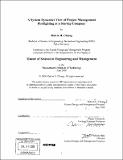A system dynamics view of project management firefighting at a startup company
Author(s)
Chiang, Melvin H. (Melvin Hsiang)
DownloadFull printable version (12.07Mb)
Other Contributors
System Design and Management Program.
Advisor
Paulo Gonçalves.
Terms of use
Metadata
Show full item recordAbstract
Fire fighting in project management is the unplanned allocation of resources to either fix problems or speed completion of a project. In a startup company environment, fire fighting oftentimes becomes the norm rather than the exception despite the best efforts to eliminate it. In particular, there are frequently constrained resources, and project managers face tough allocation decisions that can lead to a fire fighting culture. This thesis develops a system dynamics model to simulate the resource allocation decisions a group of Project Managers at a startup company must face. A current state simulation is presented with a discussion of current practices, and several future alternative scenarios are tested and analyzed. Results show that current practices allow for on-time completion of projects within reasonable work hours. Hiring of additional employees may be able to reduce the gross number of hours employees work, and workforce expansion is compared versus increased project workload to identify acceptable and sustainable levels of growth. Productivity gains in the form of increased computational speed were found to be as effective as hiring new employees, and developing in-house manufacturing capabilities may be viable depending on cost and flexibility. Unexpectedly, fire fighting behavior in the system dynamics model was observed to be minimal, and the flexibility inherent in the startup environment was a major contributor to minimizing fire fighting that did occur.
Description
Thesis (S.M.)--Massachusetts Institute of Technology, System Design and Management Program, 2008. Includes bibliographical references.
Date issued
2008Department
System Design and Management Program.Publisher
Massachusetts Institute of Technology
Keywords
System Design and Management Program.